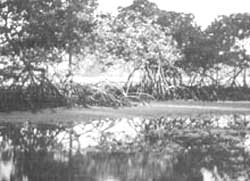Manning the groves
 a study of sea defences in northern Vietnam, carried out by researchers from the University of East Anglia and the Mangrove Ecosystem Research Centre in Hanoi, Vietnam, shows that mangroves are more effective than concrete constructions at keeping out the sea. They are now known to soften the impact of breaking waves and protect existing dykes, building up an efficient system of defence against the sea. The field studies have ironically been conducted on the delta of the Red river in the Gulf of Tongking, an area where due to the lack of awareness about the importance of mangroves, the locals are increasingly cutting them down to make way for shrimp farms. The 3,000-km-long coastline of Vietnam lies in one of the most active tropical storm regions of the world. Storms in the area have killed more than 1,000 people in the past 20 years. Increased global warming in the coming years is likely to raise sea levels and cause more severe storms. The coastal region of the country contains numerous heavily populated deltas.
a study of sea defences in northern Vietnam, carried out by researchers from the University of East Anglia and the Mangrove Ecosystem Research Centre in Hanoi, Vietnam, shows that mangroves are more effective than concrete constructions at keeping out the sea. They are now known to soften the impact of breaking waves and protect existing dykes, building up an efficient system of defence against the sea. The field studies have ironically been conducted on the delta of the Red river in the Gulf of Tongking, an area where due to the lack of awareness about the importance of mangroves, the locals are increasingly cutting them down to make way for shrimp farms. The 3,000-km-long coastline of Vietnam lies in one of the most active tropical storm regions of the world. Storms in the area have killed more than 1,000 people in the past 20 years. Increased global warming in the coming years is likely to raise sea levels and cause more severe storms. The coastal region of the country contains numerous heavily populated deltas.
While foreign consultants are busy planning higher dykes along the coastline of Vietnam and other developing countries, Mick Kelly from East Anglia University's Climatic Research Unit is of the opinion that such projects would benefit only engineers and consultants. He is of the opinion that mangroves could serve as an effective first line of defence against storms. Mangroves stabilise the sea-floor, trap sediments and reduce the angle of the seabed's slope, which helps to dissipate the energy of the breaking waves. The existing dykes could thus be protected.
Apart from providing active sea defence, mangroves are beneficial in a number of other ways. They encourage coastal fisheries by providing nutrients and sheltered spawning grounds among their flooded roots and branches. They also produce good quality timber. The flowers on these trees attract bees and help produce honey. Mangroves render so many advantages that even without their use in storm protection, their plantation proves cost-effective. Planting a hectare in the delta region requires 95 working days, which in local terms would be equivalent to the cost of 240 kg of rice. But each hectare would eventually yield 50 kg of fish annually apart from honey and timber. Above all, mangroves ensure the protection of endangered species and the conservation of biodiversity.
